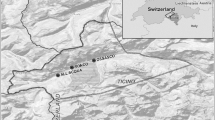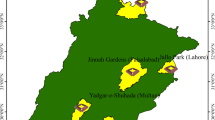Abstract
The recreational-use value of hiking in the Bellenden Ker National Park, Australia has been estimated using a zonal travel cost model. Multiple destination visitors have been accounted for by converting visitors’ own ordinal ranking of the various sites visited to numerical weights, using an expected-value approach. The value of hiking and camping in this national park was found to be $AUS 250,825 per year, or $AUS 144,45 per visitor per year, which is similar to findings from other studies valuing recreational benefits. The management of the park can use these estimates when considering the introduction of a system of user pays fees. In addition, they might be important when decisions need to be made about the allocation of resources for maintenance or upgrade of tracks and facilities.

Similar content being viewed by others
Literature Cited
ABS (Australian Bureau of Statistics). 1992. 1991 Census geographic areas. Census of population and housing. Catalogue No. 2905.0. ABS, Canberra
ABS (Australian Bureau of Statistics). 2001. Population by age and sex. Australian states and territories. Catalogue No. 3201.0. ABS, Canberra
D. R. Anderson D. J. Sweeney T. A. Williams (1990) Statistics for business and economics West Publishing New York
J. Bojö (1985) A cost–benefit analysis of forestry in mountainous areas: The case of Valadelen Stockholm School of Economics Stockholm
W. Brown F. Navas (1973) ArticleTitleImpact of aggregation on the estimation of outdoor recreation demand functions American Journal of Agricultural Economics 55 246–249
Clawson, M. 1959. Methods of measuring the demand for and value of outdoor recreation. Resources for the Future (RFF) Reprint 10. RFF, Washington, DC
M. Clawson J. L. Knetsch (1996) Economics of outdoor recreation Johns Hopkins University Press Baltimore, MD
D. A. Dillman (1978) Mail and telephone surveys: The total design method John Wiley & Sons New York
S. A. Hajkowicz G. T. McDonald P. N. Smith (2000) ArticleTitleAn evaluation of multiple objective decision support weighting techniques in natural resources management Journal of Environmental Planning and Management 43 505–518
Hanley N. D., and R. Ruffell. 1992. The valuation of forest characteristic. Working Paper No. 849. Institute for Economic Research, Queens University. Kingdom, Ontario, Canada
N. D. Hanley C. L. Spash (1993) Cost–benefit analysis and the environment Edward Elgar Cheltenham
D. Hellerstein (1992) ArticleTitleThe treatment of nonparticipants in travel cost analysis and other demand models Water Resources Research 28 1999–2004 Occurrence Handle10.1029/92WR00762
Hilger, J. R. 1998. A bivariate compound poisson application: The welfare effects of forest fire on wilderness day-hikers. Unpublished M. S. thesis, Resources and Applied Economics, University of Nevada, Reno, NV
Hotelling, H. 1949. The Economics of public recreation. The Preitt report. Land and Recreation Planning Division, National Park Service U S Dept. of the Interior, Washington, DC
Knapman, B., and O. Stanley. 1991 A travel costs analysis of the recreational use value of Kakadu National Park. Kakadu Conservation Zone Inquiry Consultancy Series KAC91/23. Kakadu Conservation Zone Inquiry, Canberra
Kuosmanen, T., E. Nillesen, and J. Wesseler. (2003. Does ignoring multi-destination trips in the travel cost method cause a systematic downward bias? Working Paper Mansholt Graduate School MWP-09. Wageningen University, The Netherlands
Loomis, J. B., 2001. Final Snake River contingency value methodology study report. Submitted to the Wyoming Bureau of Land Management, Cheyenne, Wyoming
J. B. Loomis R. G. Walsh (1997) Recreation economic decisions: Comparing benefits and costs Venture Publishing, State College PA
P. Nijkamp P. Rietveld H. Voogd (1990) Multicriteria evaluation in physical planning Elsevier Amsterdam
Nillesen, E., J. Wesseler, and A. Cook. 2003. Correcting for multiple destination trips in recreational use values. An application to Bellenden Ker National Park, Australia, Working Paper Mansholt Graduate School MWP-07, Wageningen University, Waqeningen, The Netherlands
R. Perman Y. Ma J. McGilvray M. Common (2003) Natural resource and environmental economics Pearson London
NRMA, 2002. Vehicle operating costs. Available from http://www.mynrma.com.au/motoring/cars/car_mr_op_about.shtml (accessed Novemeber 2001)
P. Rietveld (1989) ArticleTitleUsing ordinal information in decision making under uncertainty System Analysis, Modeling, Simulation 6 659–672
W. D. Shaw P. Feather (1999) ArticleTitlePossibilities for including the opportunity costs of time in recreation demand systems Land Economics 75 592–602
Stoeckl, N. 1993. A travel cost analysis of Hinchinbrook National Park, PhD thesis, James Cook University of North Queensland, Townsville, Australia
N. Stoeckl (1995) A travel cost analysis of Hinchinbrook National Park B. Faulkner M. Fagence M Davidson S. Craig-Smith (Eds) Tourism research and education in Australia Bureau of Tourism Research Canberra 181–201
A. H. Trice S. E. Wood (1958) ArticleTitleMeasurement of recreational benefits Land Economics 3 195–207
F. A. Ward D. Beal (2000) Valuing nature with travel cost models. A manual Edward Elgar Cheltenham, UK
K. G. Willis G. D. Garrod (1991) ArticleTitleAn individual travel cost method of evaluating forest recreation Journal of Agricultural Economics 42 33–42
InstitutionalAuthorNameWTMA (2000) Wet Tropics nature based tourism strategy WTMA Cairns, Australia
D. Xue A. Cook C. Tisdell (2000) ArticleTitleBiodiversity and the tourism value of Changbai Mountain Biosphere Reserve, China: A travel cost approach Tourism Economics 6 335–357
Acknowledgments
The Rainforest Cooperative Research Centre, Cairns, and the School of Economics, University of Queensland, Brisbane provided financial support for the case study. We are indebted to Hans-Peter Weikard and Steve Harrison for their valuable comments on an earlier version of this article Suggestions from three reviewers and the editor, Virginia Dale, are greatly appreciated.
Author information
Authors and Affiliations
Corresponding author
Appendix: The Expected Value Approach to Ranked Criteria Adopted from Nijkamp and others (1990)
Appendix: The Expected Value Approach to Ranked Criteria Adopted from Nijkamp and others (1990)
Assuming that J criteria need to be ranked in increasing order of importance and that weights are nonnegative and add up to 1, the set of feasible weights is
It is assumed that the probability density function of the weights is equal for all values in S. Thus, a uniform distribution of the weights in S is derived:
In Rietveld (1989), it is shown that c = (J−1)!J !. Once the values γ1,...,γJ-1 are known, the value of γJ can be found as
The expected values of γ1,...,γJ−1 are the cardinalized values of rank numbers of 1,...,J. The expected value of an arbitrary γ j is given by:
where
After integrating out γJ−1, γJ−2,. γJ+1 in Equation A3, the following is obtained:
Integrating out rj in Equation in A5 and making use of the fact that the primitive function of x(a-x)n equals
the following results can be obtained after the appropriate integrations (Rietveld, 1989):
Rights and permissions
About this article
Cite this article
Nillesen, E., Wesseler, J. & Cook, A. Estimating the Recreational-Use Value for Hiking in Bellenden Ker National Park, Australia. Environmental Management 36, 311–316 (2005). https://doi.org/10.1007/s00267-003-0219-7
Published:
Issue Date:
DOI: https://doi.org/10.1007/s00267-003-0219-7




